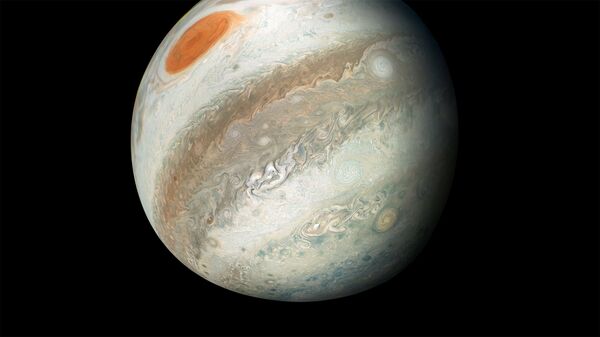The gas giant planet Jupiter could have collided with a “proto-planet” approximately 10 times as big as Earth and swallowed it whole during the early days of the Solar System, a group of researchers say.
A joint group of scientists from China, Switzerland, Japan and the US created a model that seeks to explain the discrepancies in Jupiter’s structure discovered by NASA’s Juno spacecraft. According to gravitational readings, the planet’s core is less dense and more extended than expected.
"This is puzzling," said Andrea Isella, a co-author of the study. "It suggests that something happened that stirred up the core, and that's where the giant impact comes into play."
Published in Nature magazine, the new model suggests that the strange core structure may be a result of an impact with a huge rocky or icy “planetary embryo” in the first few million years of Jupiter’s formation.
A colossal, head-on collision between #Jupiter and a still-forming planet in the early solar system, about 4.5 billion years ago, could explain surprising readings from @NASAJuno, according to a study this week in @nature. https://t.co/OLnCbVlKhF @RiceUniversity @physorg_com pic.twitter.com/HgSVNHkrU7
— The SETI Institute (@SETIInstitute) August 15, 2019
"The only scenario that resulted in a core-density profile similar to what Juno measures today is a head-on impact with a planetary embryo about 10 times more massive than Earth," said Shang-Fei Liu, the study's lead author.
“A sufficiently giant impact between a large planetary embryo and the proto-Jupiter could have shattered its primordial compact core and mixed the heavy elements with the inner envelope,” the study reads.
Isella explains that, after the supposed impact, it took billions of years for the proto-planet’s heavy material to settle back into Jupiter’s dense core.
"It sounded very unlikely to me," Isella admitted, adding that it was "like a one-in-a-trillion probability.”
The team also ran alternative scenarios, such as weather erosion or a presumption that Jupiter’s core always contained gas, but the impact model came with the results that matched the Juno reading best, The Daily Mail report said.
“Models of such a scenario lead to an internal structure that is consistent with a diluted core, persisting over billions of years,” the study reads.
Based on their research, scientists speculate that similar collisions were not rare during the early days of the Solar System.
"We suggest that collisions were common in the young Solar System and that a similar event may have also occurred for Saturn, contributing to the structural differences between Jupiter and Saturn,” the study says.

